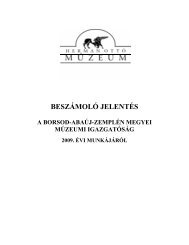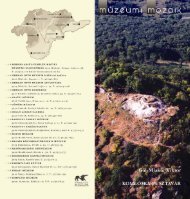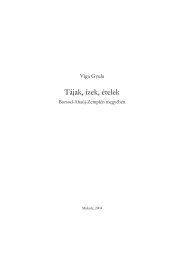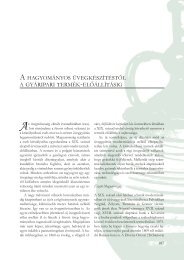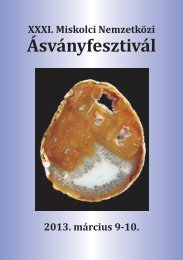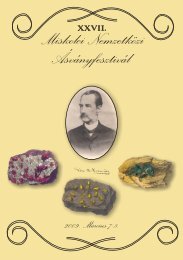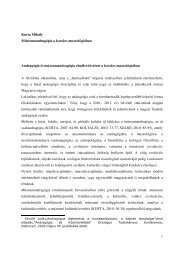Acta Mineralogica-Petrographica, Abstract Series 5, Szeged, 2006ENVIRONMENTAL RADIOCHEMISTRY AND COMPLEX ENVIRONMENTALGEOCHEMISTRY OF YOUNG LAKE SEDIMENTS AT <strong>THE</strong> SZEGED FEHÉR-TÓ,HUNGARYPÁL-MOLNÁR, E., BOZSÓ, G. & FRIEBERT, Z.Department of Mineralogy, Geochemistry and Petrology, University of Szeged, P.O. Box 651, H-6701 Szeged, HungaryE-mail: palm@geo.u-szeged.huOur study is focusing on the effects of natural radioactiveelements of young lake sediments on living organisms. Besideswe searched for the reasons for the enrichment of naturalradionuclides and trace contaminants in the sediment ofSzeged Fehér-tó Lake.The Szeged Fehér-tó is well known of intensive fishbreeding, and our study area was allocated on two hatcheriesof the lake system. Hatcheries have got a complex environmentalrole, since large areas of them fall under natural protection(Kiskunság National Park), as the territory has got amajor ornithological importance. Radioactive elements(members of natural radioactive series) and heavy metals inthe sediment might have indirect effects on humans, as wellas on birds migrating and feeding in the area.The aim of the study was to measure the natural γ-radiation, determining the amount of natural radionuclides( 238 U, 232 Th, 40 K), and to determine the total γ-radiation of thearea. Besides, main element and trace element compositions,mineral composition and total carbon content were measuredin order to determine the causes of radionuclide enrichmentin the sediment.Main and trace element contents were determined with X-ray fluorescence (XRF). Based on the results of these measurementsrepresentative samples were chosen for further X-ray diffraction (XRD) analysis. These provided the means fordetermining the mineral composition of sediments on thearea. Results show mineralogical homogeneity. Total organiccarbon content (TOC) was measured with Rock-Eval pyrolysisfor representative samples of the two hatcheries.The enrichment or the anomalies in the normal distributionof radionuclides and trace contaminants in the sedimentof the lakes cannot be interpreted, unless the distribution ofthe medium, carrying these elements is known. XRD andTOC measurements were carried out for this reason. Basedon the results, element distribution maps and correlationcharts were compiled, presenting the relations between main,trace and radioactive elements. The enrichment of radioactiveand contaminant elements were understood with the help ofthese relations.Analyses have shown that irrespective of the methods ofextraction the radionuclide concentration is 5-10 times higherthan the average data for saline lakes, however concentrationshigher than the natural value by an order of magnitude ormore did not occur. The research proved that natural isotopescould be linked to argillic minerals, oxides with good absorptioncapabilities, and heavy minerals. Main and trace elementcontents of the lake sediments do not exceed the usual valuesby an order of magnitude, nevertheless the concentrations ofsome trace elements (As, Cr, Cu) are close to the contaminationthreshold, and other trace elements (Mn, Ni) appear inlarger quantities, than it was previously expected.Based on the results of our research we recommend furtherdosimetric and trace element analyses in the area.88www.sci.u-szeged.hu/asvanytan/acta.htm
Acta Mineralogica-Petrographica, Abstract Series 5, Szeged, 2006LAPIDATOR PROJECT – KOCH SÁNDOR <strong>M<strong>IN</strong>ERAL</strong> COLLECTION, DEPARTMENT OF<strong>M<strong>IN</strong>ERAL</strong>OGY, GEOCHEMISTRY AND PETROLOGY, UNIVERSITY OF SZEGEDPÁL-MOLNÁR, E. & JÁNOSI, T.Department of Mineralogy, Geochemistry and Petrology, University of Szeged, P.O. Box 651, H-6701 Szeged, HungaryE-mail: palm@geo.u-szeged.huThe main goal of the Lapidator Project is to compile thedigital archive of the Koch Sándor Mineral Collection, whichis located at the Department of Mineralogy, Geochemistryand Petrology, University of Szeged. The archive would bemanaged by an up-to-date software, handling 2D and 3Dphotographs and databases on the characteristics of minerals.As an early outcome of the project we have already set upa software, which goes well beyond the execution of ordinarydatabase commands, and ensures the technical backgroundfor various educational, demonstrational and promotionalprojects.Preliminary works have started with the planning of thegeneral setup of the system. As a first step a Systematic MineralogyDatabase was constructed on the basis of the IMA(International Mineralogical Association) accepted minerals(www.mindat.org,www.webmineral.com,www.matident.com, etc.). This contains the name, taxonomy,formula, elementary composition, physical characteristics,and photographs of the minerals. Further sub-databases werealso added to the software in order to enhance the primary,systematic framework. These are: the digital Koch SándorMineral Database, the archive of Hungarian mineralogicalpublications, and the most important places of occurrenceswithin the Carpathian Basin, supplemented with maps. Thebasis of the software, i.e. the Systematic Mineralogy Database,also provides a didactic guideline for the user to digestthe presented knowledge. The digital Koch Sándor MineralDatabase includes all the 6000 minerals of the collection,with 3D rotating images of some of the most beautiful pieces,exhibited at the department in glass-cases. With a simplesearch one can gather the publications of the previous decadesthat write about or mention a chosen mineral. Furtherimportant information can be gained by checking the placesof occurrence and accessibility on maps covering the wholeCarpathian Basin. Beside all of these, the software can alsogive a historical view on the life and work of famous scientistsdealing with mineral collection.The appearance of the software was designed to be simpleand elegant at the same time. Different options can be accessedeasily, while parameters referring to each other andhypertext solutions provide a web like character for the wholesystem. In accordance with the Hungarian user environmentthe software is supported by Win32 based operational systems,however current developments aim at involving Macintoshbased systems too. The installed software downloadsupdates and changes in the database through the Internetautomatically, thus the user is always faced with the latestversion of the digital collection.In all we have produced a software which is ready to beapplied by people of any age, both with a professional ornon-professional background and either for research or simplyfor studying the wonders of minerals.www.sci.u-szeged.hu/asvanytan/acta.htm 89
- Page 1:
MSCC33 rd MINERAL SCIENCES IN THE C
- Page 5 and 6:
Acta Mineralogica-Petrographica, Ab
- Page 7 and 8:
Acta Mineralogica-Petrographica, Ab
- Page 9 and 10:
Acta Mineralogica-Petrographica, Ab
- Page 11 and 12:
Acta Mineralogica-Petrographica, Ab
- Page 13 and 14:
Acta Mineralogica-Petrographica, Ab
- Page 15 and 16:
Acta Mineralogica-Petrographica, Ab
- Page 17 and 18:
Acta Mineralogica-Petrographica, Ab
- Page 19 and 20:
Acta Mineralogica-Petrographica, Ab
- Page 21 and 22:
Acta Mineralogica-Petrographica, Ab
- Page 23 and 24:
Acta Mineralogica-Petrographica, Ab
- Page 25 and 26:
Acta Mineralogica-Petrographica, Ab
- Page 27 and 28:
Acta Mineralogica-Petrographica, Ab
- Page 29 and 30:
Acta Mineralogica-Petrographica, Ab
- Page 31 and 32:
Acta Mineralogica-Petrographica, Ab
- Page 33 and 34:
Acta Mineralogica-Petrographica, Ab
- Page 35 and 36:
Acta Mineralogica-Petrographica, Ab
- Page 37 and 38: Acta Mineralogica-Petrographica, Ab
- Page 39 and 40: Acta Mineralogica-Petrographica, Ab
- Page 41 and 42: Acta Mineralogica-Petrographica, Ab
- Page 43 and 44: Acta Mineralogica-Petrographica, Ab
- Page 45 and 46: Acta Mineralogica-Petrographica, Ab
- Page 47 and 48: Acta Mineralogica-Petrographica, Ab
- Page 49 and 50: Acta Mineralogica-Petrographica, Ab
- Page 51 and 52: Acta Mineralogica-Petrographica, Ab
- Page 53 and 54: Acta Mineralogica-Petrographica, Ab
- Page 55 and 56: Acta Mineralogica-Petrographica, Ab
- Page 57 and 58: Acta Mineralogica-Petrographica, Ab
- Page 59 and 60: Acta Mineralogica-Petrographica, Ab
- Page 61 and 62: Acta Mineralogica-Petrographica, Ab
- Page 63 and 64: Acta Mineralogica-Petrographica, Ab
- Page 65 and 66: Acta Mineralogica-Petrographica, Ab
- Page 67 and 68: Acta Mineralogica-Petrographica, Ab
- Page 69 and 70: Acta Mineralogica-Petrographica, Ab
- Page 71 and 72: Acta Mineralogica-Petrographica, Ab
- Page 73 and 74: Acta Mineralogica-Petrographica, Ab
- Page 75 and 76: Acta Mineralogica-Petrographica, Ab
- Page 77 and 78: Acta Mineralogica-Petrographica, Ab
- Page 79 and 80: Acta Mineralogica-Petrographica, Ab
- Page 81 and 82: Acta Mineralogica-Petrographica, Ab
- Page 83 and 84: Acta Mineralogica-Petrographica, Ab
- Page 85 and 86: Acta Mineralogica-Petrographica, Ab
- Page 87: Acta Mineralogica-Petrographica, Ab
- Page 91 and 92: Acta Mineralogica-Petrographica, Ab
- Page 93 and 94: Acta Mineralogica-Petrographica, Ab
- Page 95 and 96: Acta Mineralogica-Petrographica, Ab
- Page 97 and 98: Acta Mineralogica-Petrographica, Ab
- Page 99 and 100: Acta Mineralogica-Petrographica, Ab
- Page 101 and 102: Acta Mineralogica-Petrographica, Ab
- Page 103 and 104: Acta Mineralogica-Petrographica, Ab
- Page 105 and 106: Acta Mineralogica-Petrographica, Ab
- Page 107 and 108: Acta Mineralogica-Petrographica, Ab
- Page 109 and 110: Acta Mineralogica-Petrographica, Ab
- Page 111 and 112: Acta Mineralogica-Petrographica, Ab
- Page 113 and 114: Acta Mineralogica-Petrographica, Ab
- Page 115 and 116: Acta Mineralogica-Petrographica, Ab
- Page 117 and 118: Acta Mineralogica-Petrographica, Ab
- Page 119 and 120: Acta Mineralogica-Petrographica, Ab
- Page 121 and 122: Acta Mineralogica-Petrographica, Ab
- Page 123 and 124: Acta Mineralogica-Petrographica, Ab
- Page 125 and 126: Acta Mineralogica-Petrographica, Ab
- Page 127 and 128: Acta Mineralogica-Petrographica, Ab
- Page 129 and 130: Acta Mineralogica-Petrographica, Ab
- Page 131 and 132: Acta Mineralogica-Petrographica, Ab
- Page 133 and 134: Acta Mineralogica-Petrographica, Ab



